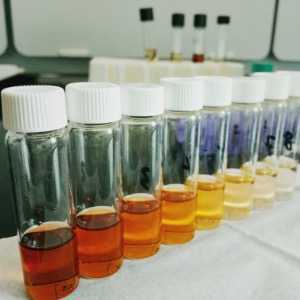Sep 17, 2021
Standard operating procedure of glassware cleaning
This protocol is a draft, published without a DOI.
- 1Dalhousie University
- Marine Microbial Macroecology LabTech. support email: ruby.hu@dal.ca

Protocol Citation: Ying-Yu Hu 2021. Standard operating procedure of glassware cleaning. protocols.io https://protocols.io/view/standard-operating-procedure-of-glassware-cleaning-byb6psre
License: This is an open access protocol distributed under the terms of the Creative Commons Attribution License, which permits unrestricted use, distribution, and reproduction in any medium, provided the original author and source are credited
Protocol status: Working
We use this protocol and it’s working
Created: September 17, 2021
Last Modified: September 17, 2021
Protocol Integer ID: 53342
Abstract
In our Marine Microbial Macroecology Lab, we focus on microalgae cultivation and macromolecule measurement. We expect all lab members to use the standard operating procedure of glassware cleaning, so that (1) personal safety and environmental safety are both under control; (2) the shared acid bath is not contaminated; and (3) glassware is proper cleaned for the research.
Materials
For acid bath:
Equipment
HDPE rectangular heavy duty lab tank with cover
NAME
Nalgene
BRAND
14100-0015
SKU
Safety warnings
- Acid is corrosive, contact with skin will cause burns. Its fume can irritate your airways.
- Phosphate-free detergent is corrosive and may cause severe burns.
- Acid fume from an uncovered container can harm the facilities in the lab.
- The spill of water, acid and detergent on the floor can cause slippery hazard.
- Broken glass pieces from the sink are severely dangerous.
- Polycarbonate filters left in the sink can clog the water drainage system.
Before start
Have personal protective equipment ready:
- lab coat
- safety glasses or goggles
- nitrile gloves
- heavy-duty gloves
Wash
Wash
Dispose hazardous material in the appropriate waste location.
Remove filter or other items from the glassware.
Put small items, such as filter holder mesh, stir bar, cap…etc. in a beaker or container, so that they won’t get lost during washing.
Rinse glassware with tap water to remove dirt, stain, and residue of chemicals.
Soak small items in the glassware detergent bath, make sure the glassware is filled with detergent bath and no air bubbles are seen. Label the detergent bath container or tray with name and date to have lab members informed.
For oversized items, fill the item with detergent bath full or partially, cap the item and flip them for a better soak. Place items in a tray to avoid detergent spill. Label the tray with name and date to have lab members informed.
Rinse glassware with tap water and then DI water.
Acid wash
Acid wash
12h
12h
All glassware must be detergent washed and spotless before going into acid bath.
Check the position of extraction arm before removing the lid of the acid bath tank, which should be over the acid bath tank.
Place glassware gently and carefully into the bath tank.
Place small items such as caps, stir bars, filter mesh…etc. into a bottle or a small basket. Fill the bottle with acid, cap the bottle.
Equipment
Polypropylene autoclaving baskets
NAME
Nalgene
BRAND
6917-0127
SKU
Soak small sized items in the acid-bath tank, make sure the glassware is filled with acid and no air bubbles are seen.
For oversized items, fill the item with acid(full or partially), cap the item and flip them for a better soak. Place items in a second container (for example, polypropylene pan) to avoid acid spill. Label the tray with name and date to have lab members informed.
Equipment
Large polypropylene sterilizing pan
NAME
Nalgene
BRAND
6900-0010
SKU
Rinse
Rinse
Fill a carboy with DI water.
Check the position of extraction arm before removing the lid of the acid bath tank, which should be over the acid bath tank.
Empty acid from the items and allow acid drip back into the bath for a few moments.
Transfer them from the acid bath into a clean pan.
Cover the acid bath and clean the acid spill with baking soda immediately.
Rinse each glassware (in and out) at least three times with DI water. For meticulously clean glassware on very sensitive projects, rinse with Milli-Q water afterwards.
Dry
Dry
Drain the glassware for a few moments.
Place glassware upside down in a clean basket and dry in the gravity oven at 60 °C
Air dry graduated cylinder, volumetric flask and serological pipets.
Prepare acid bath
Prepare acid bath
Concentration of acid bath varies.
Example for a 5% acid bath:
37% HCl: 1.5L
DI: 10L
Prepare acid in the carboy.
In the fume hood, add acid into DI water.
Check the position of extraction arm, which should be over the acid bath tank.
Carefully fill tank with prepared acid.
Cover the acid bath and clean the acid spill with baking soda immediately.
Label the acid tank with NFPA label.
Dispose acid
Dispose acid
Neutralize acid bath by slowly adding acid into baking soda solution to prevent vigorous reaction, stir the mixture with polypropylene rod or stir bar retriever.
Equipment
Stir bar retriever
NAME
Fisherbrand
BRAND
14-513-70
SKU
Cleanup
Cleanup
Neutralize acid on the bench counter with baking soda.
Pick up all broken glass pieces and filter from the sink.
Wipe up all spills and water.
Rinse heavy-duty gloves and hang them on the rack.
Check if the acid-bath is properly located and capped.
